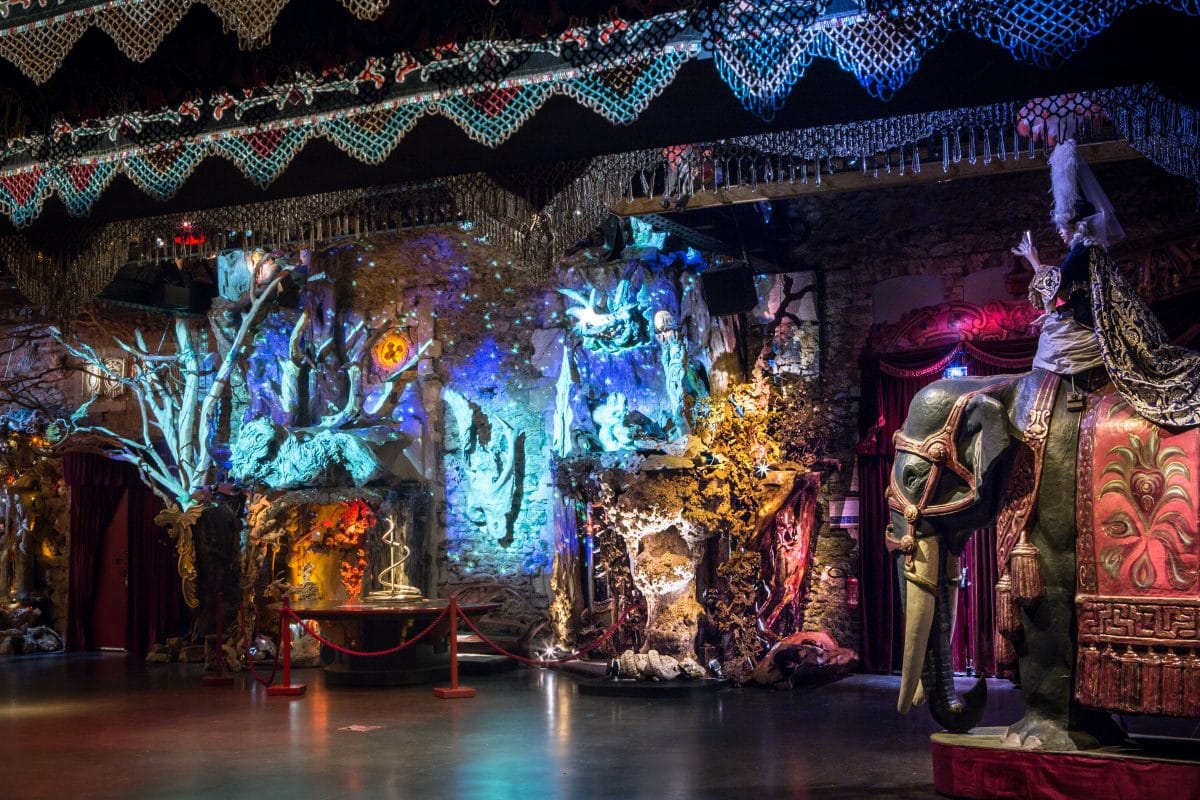« Laughter is not taken seriously is a phrase I have often said regarding amusement heritage. It is the reason that prevented these objects from being displayed in a traditional museum, when France as so many museums for war and work. »
– Jean Paul Favand
AN INNOVATIVE DISPLAY
In his attempts to create a lively memory of performing and fairground arts, Jean Paul Favand was confronted with the rigidity of traditional museum displays.He wasn’t looking to create a place of nostalgia, but instead somewhere similar to his bistrot, the Tribulum, animated and joyful. He wanted the display to pay homage to the traditions of entertainment, but also to its original function : to make people’s dreams come true.
Therefore, Jean Paul Favand developed an object-staging approach, considering himself as a stage director and his objects as a theatrical troupe.
For this unique production, objects were carefully selected from his collection for their strong evocative power. Secondly, to uncover this evocative power, objects were treated by passionate conservators with respect to the objects’ historical and cultural value as well as conservation standards. Finally, objects were meticulously positioned and lighting was used to accentuate them and guide the visitors’ eyes.
« The idea is to give the floor back (to the object), to awake its expressions, to seize its essence. »
A curiosity exhibitor and objects matchmaker
This approach is complemented with the concept of object matchmaking – enabling the objects to interact not only with the visitors but also with the other objects in the room. This, along with the absence of display cases and labels creates a unique closeness between the spectators and the acting-objects. Visitors are invited to meander not only as spectators but as actors in the scenes, creating their own tour by following their artistic sensitivity and discovering the objects as the walk by.
« My approach is somehow similar to the Renaissance autodidact Humanists. Back in the time of cabinet of curiosities knowledge was acquired through what the senses could perceive (sight, touch). As the science of the Humanist resulted of their intuition, not their reason.»
Jean Paul Favand designed Musée des Arts Forains to be timeless. Visitors are invited to interact and touch the objects, an experience that makes the forget about their everyday tasks. The museum does for its guests what the funfairs of the Belle Epoque did for their visitors : it enables visitors to be carried away and to live in the moment.
The conservation & restoration workshop : bringing back the objects’ magic
Preservation and conservation of Jean Paul Favand’s unique collection is one of the fundamental activities at the Pavillons de Bercy.
The Pavillons de Bercy wineries house their own on-site conservation studio, including a permanent conservation team and occasionally specialized contractors who work hard to bring back the magic of the objects.
Our conservation ethic is based on a documentation and research approach. Archivists, museum experts, conservators and exhibition designers from the Pavillons de Bercy have analyzed more than 29 000 documents, postcards, and carousel makers’ catalogues from all across Europe to help in the restoration of centenarian objects.
Most of fairground art artifacts continuously repainted throughout their lives, leaving up to 15 layers of paint on a single wooden horse. It can take up to 3 months for our conservation team to remove each layer, eventually revealing the original polychrome aspect of the object and the delicacy of the original carving.
The restoration of a carousel can require the work of many specialists. The Caillebaut et Decanck Velocipede ride from 1897 on display in the Musée des Arts Forains, has undergone more than 20 000 hours of restoration work. The treatment included building a new central mast, as the old one had been damaged by the former steam engine; consolidating the worm-eaten rounding boards; putting the painted canvases on new wooden backings, and removing three layers of paint ( one gold and red paint , the second with the showman’s initials, the third with landscapes).
This project brought together conservators from 18 different specialities: painting, sculpture, woodwork, metalwork, leather and textile, engineers and electricians…
Because the engines had not worked for many decades, specialised mechanics had to recreate missing parts to enable this carousel to go round once again. Preventive conservation and maintenance are also an everyday task, taken care by our conservators under Jean Paul Favand’s supervision.
Once every year, for the European Heritage days, we open our conservation and restoration studios and organise meet-ups between our conservators and the visitors to showcase the importance of their work.
A living heritage company
The unique expertise and savoir-faire of the collaborators of the Pavillons de Bercy has been recognized and awarded with the national label “Entreprise du Patrimoine vivant” (Living Heritage company) in 2009.
This label was set up by the French government to distinguish companies with excellent artisanal and industrial expertise.
It is a recognition of the Pavillons de Bercy’s proficiency regarding the conservation, restoration and documentation of performing and fairground art heritage to museum standards.
The conservation team has enabled the preservation of an unknown form of heritage and the recognition of a folk art.
The label was originally attributed for a 5 years period and was renewed in 2015 after examination by a national commission.
Published on 09.01.17
